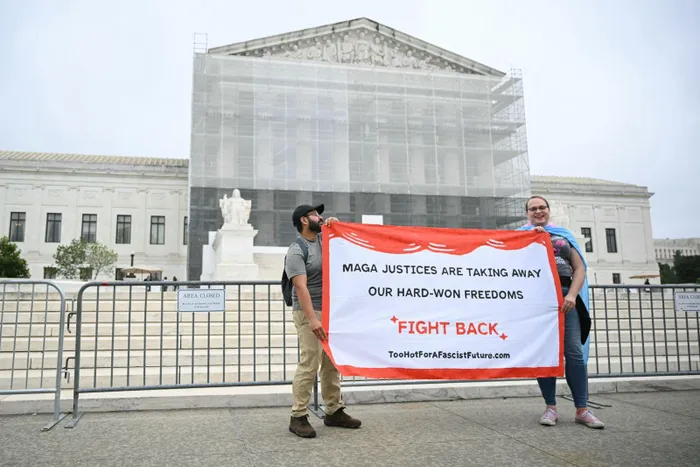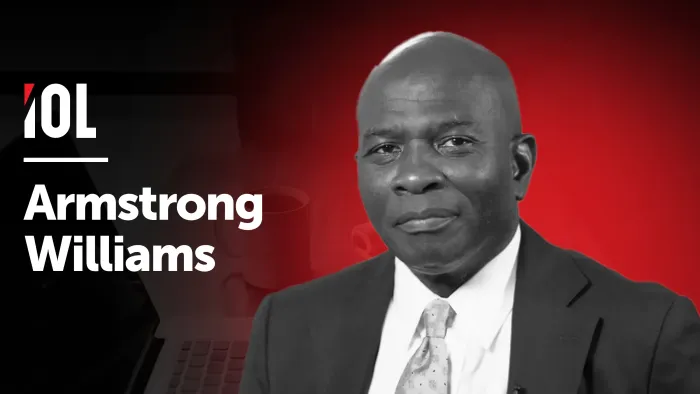Is the US Supreme Court a Trump Court?

Demonstrators hold a banner outside the US Supreme Court, on the final day of the Court's term, in Washington, DC, on June 27, 2025. The US Supreme Court is to issue its final rulings on Friday ahead of its summer break, including cases involving birthright citizenship, porn site age verification, students and LGBTQ-themed content, and voting rights.
Image: Mandel Ngan / AFP
Has the United States Supreme Court become a Trump Court with three Trump appointees: Associate Justices Neil Gorsuch, Brent Kavanaugh, and Amy Coney Barrett? The short paradoxical answer is “yes” and “no”.
For starters, a substantial percentage (40-50%) of Supreme Court decisions in any term are unanimous. But not all cases are equally significant. Some plow pioneering constitutional territory, for example, Trump v. United States bestowing criminal immunity on all presidential acts. Others overrule long standing precedents, for example, Dobbs v. Jackson Women’s Health Organization overruling Roe v. Wade’s recognition of a constitutional right to an abortion.
Trump appointee Justice Barrett has displayed an independent streak in garden variety cases. But she is a reliable member of a 6-member majority in major constitutional or quasi-constitutional cases with Chief Justice John Roberts and Associate Justices Clarence Thomas, Samuel Alito, Neil Gorsuch, and Brent Kavanaugh. The Chief Justice and Justice Alito are appointees of President George W. Bush. Justice Thomas was appointed by President George H. W. Bush. Neither Bush #41 nor Bush #43 are MAGA cheerleaders. In other words, the 6-member conservative majority represents a broader political consensus than Mr. Trump himself.
Moreover, Trump’s influence on the Supreme Court has been less than President Franklin D. Roosevelt’s. The latter appointed eight new Justices, all New Deal enthusiasts, and elevated Associate Justice Harlan Fiske Stone to Chief Justice. The Roosevelt Court revolutionized congressional power under the Commerce Clause and presidential power over national security and foreign policy.
Supreme Court Justices serve for life to encourage their independence from the Presidents who appointed them. Experience shows mixed success on that score. Justices do occasionally disappoint their benefactors. President Theordore Roosevelt appointed Justice Oliver Wendell Holmes, Jr. But within a year he complained about a Holmes dissent, “I could carve out a banana, a judge with more backbone than that. President Harry Truman appointed his Attorney General, Tom C. Clark, who voted against him in the famous Steel Seizure Case. President Dwight Eisenhower reportedly regretted his appointment of Chief Justice Earl Warren and Associate Justice William Brennan as “my two worst mistakes.” President Richard Nixon appointed Chief Justice Warren Burger and Associate Justice Harry Blackmun. But the former authored the Nixon tapes case which led to the President’s resignation and the latter pioneered a constitutional right to abortion in Roe v. Wade. Justice Anthony Kennedy proved a disappointment to President Ronald Reagan and Justice David Souter disappointed Bush #41.
The Trump Court voted against President Trump’s anti-immigration initiatives to end President Barack Obama’s Deferred Action for Childhood Arrivals in DHS v. Regents of the University of California and to reinstate a Census citizenship question in Department of Commerce v. New York. Further, the Court held in its most recent term in Noem v. Abrego Garcia (April 10, 2025) that President Trump was required to “facilitate’ the return of a wrongly deported immigrant from a dungeon in El Salvador.
But these exceptions prove an important rule. Justices of the Supreme Court, by and large, do reflect the political inclinations of their presidential benefactors. Thus, the Trump Court has followed Trump’s lead on freedom of religion, guns, LGBTQ people, the environment, deregulation, national security, and unchecked presidential power. In Trump v. CASA Inc. (June 27, 2025), the Court clipped the wings of subordinate tribunals to restrain unconstitutional executive orders coming out of the gate.
Over the long haul, the Supreme Court never strays far from public opinion. As fabled Justice Benjamin Cardozo elaborated, “The great tides and currents which engulf the rest of men do not turn aside in their course and pass the judges by.”
* Armstrong Williams (www.armstrongwilliams.com; @arightside) is a political analyst, syndicated columnist and owner of the broadcasting company, Howard Stirk Holdings. He is also part owner of The Baltimore Sun.
** The views expressed here do not necessarily represent those of Independent Media or IOL.

Armstrong Williams explores whether the US Supreme Court has truly become a 'Trump Court' under the influence of three Trump appointees, and how this compares to historical precedents set by past presidents.
Image: IOL
Related Topics: